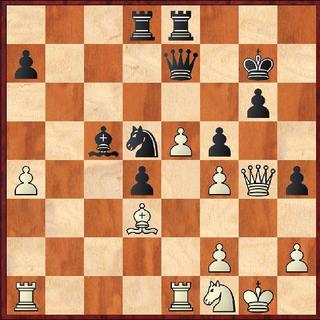White to Play
Published in Chess Puzzles

Being successful at chess often requires that you be alert to possibilities in what may look like an even position. Today’s position is a gem of an example from Kramer-Horowitz, New York, 1948. Black has just played his pawn from f7 to f5 on his 28th move, attacking White’s queen. White comes up with a wonderful way to win a piece. Hope you find it!
By the way, our last puzzle generated some mail that thought I had missed something. You’ll find my reply to that in the answer as well!
Solution:
OK, let’s get some old business out of the way. In the last puzzle several people thought the Rxf6 wasn’t necessary and just wanted to go ahead with Bh7, Qh5 and Rh3. The reason Rxf6 was necessary was that if you don’t take the bishop, the clergy will take the pawn on d4 with check and then play f6, creating an escape square and winning! Always remember that the other guy can come up with moves, too!
As for our current puzzle, we hoped you noticed that White has an en passant capture since the f-pawn, as noted, went from f7-f5 on his 28th move; however, that’s not the trick. Catch this brilliant way of exchanging that wins a piece, then ask yourself what you needed to see in the above position to create this sequence of moves. Play them in your head from the diagram—very instructive: 29.exf6+ Qxf6 30.Rxe8 Rxe8 31.Qd7+ Qf7 32.Qxf7+ Kxf7 33.Bc4 Rd8 34.Re1 Kf6 35.Re5, winning the piece. The key to all this is seeing the pin that gets set up by Bc4 and then the ingenious maneuver of the rook from a1 to e1 to e5. No flashy sacrificial attack, but decisive nevertheless and a part of how to win at chess. We can’t get excited enough about this because we all learn from this one!
Send questions and comments to PTamburro@aol.com.






